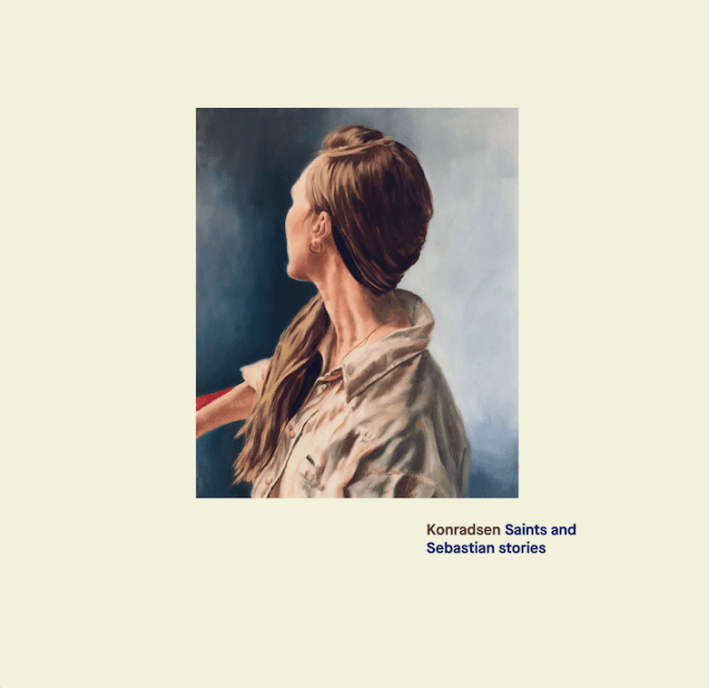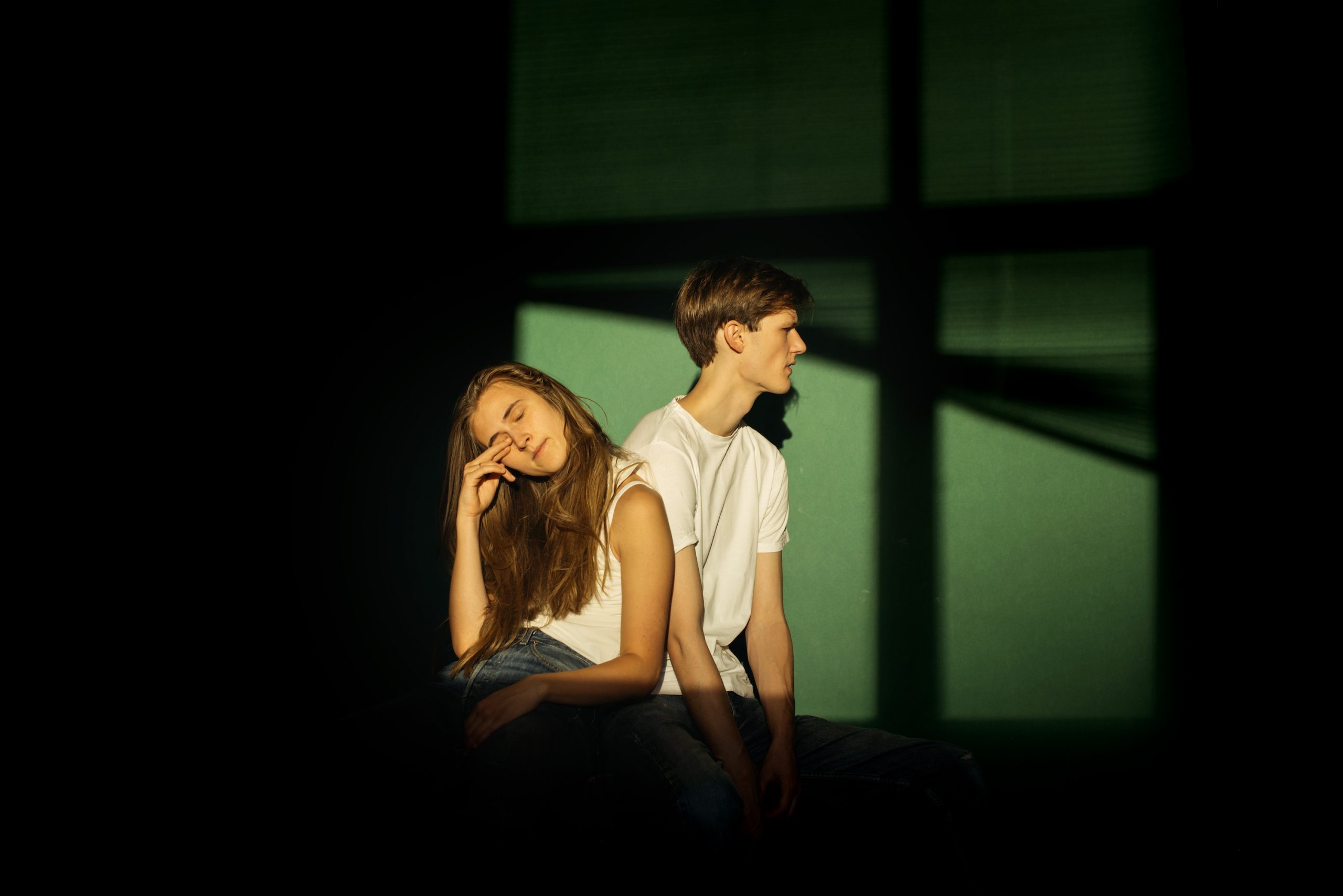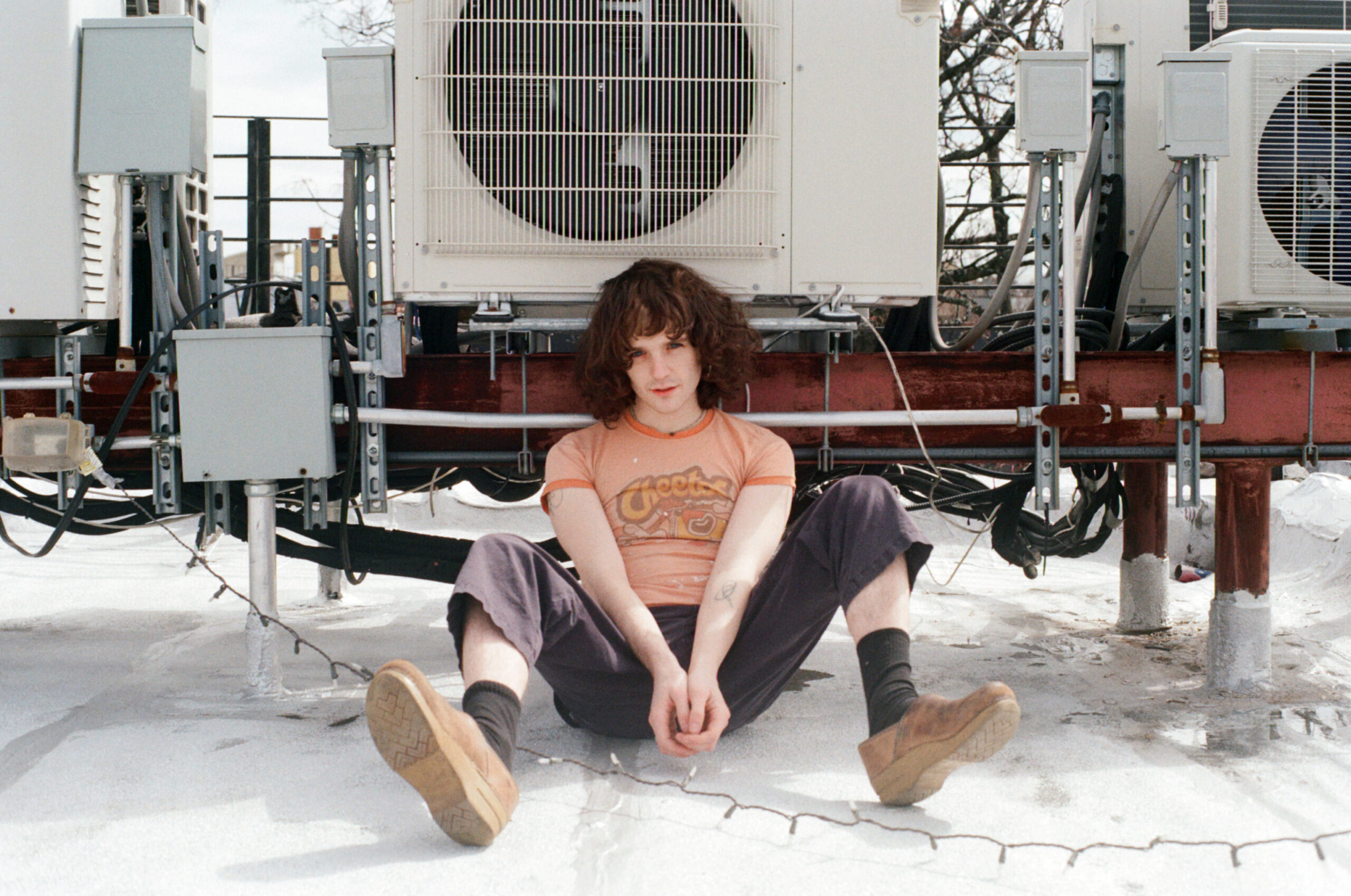Of the many reasons artists have missed interviews -- schedule conflicts, illness, feigned illness -- childbirth is among the most reasonable. The original plan was to Skype with both members of the Oslo duo Konradsen, but vocalist and pianist Jenny Marie Sabel was unavailable due to the strong likelihood of induced labor. Fortunately, multi-instrumentalist Eirik Vildgren was still around to shed light on one of the most spectacular debut albums in recent memory.
Saints And Sebastian Stories, out in October, culminates a decade of friendship between Sabel, 24, and Vildgren, 26. The two met as teenagers in northern Norway, where both came of age in tight-knit communities. Sabel was raised in an intentional religious enclave on a campground her hippie parents purchased with friends in the '70s. Vildgren spent much of his childhood in a fishery in the fjords of Senja before finding himself in the creative scene at the island's Kråkeslottet community center. They've since moved to Oslo, where they forged a powerful musical partnership at university.
Both members of Konradsen cite the communities that raised them as essential components informing their music. Sometimes that becomes literally true: Voices of their loved ones are threaded throughout Saints And Sebastian Stories via samples, manipulated audio snippets, and the occasional gang vocal. Yet the duo's melancholy ballads are strikingly intimate, like private bedroom recordings that open up a portal to somewhere celestial. They infuse their tender organic instrumentation with a futuristic minimalism, occasionally blowing out the music into extravagant flourishes of beauty without losing their gentle touch.
The album evokes a wide range of touchpoints -- the folksy post-rock epics of Sufjan Stevens' Michigan, the avant-R&B deconstructions of Frank Ocean's Blonde, the otherworldly sprawl of Sigur Rós, the warmly glowing adult contemporary pop of London Grammar, the ornate indie-folk of the Staves -- but as with those acts, the end product is resistant to category. In the three years since Konradsen became their primary creative concern, Sable and Vildgren have honed a gorgeous, heartrending sound all their own. Maybe it doesn't quite measure up to the wonder of birthing a human life into the world -- congratulations are in order for Sabel, who reportedly had her baby last night -- but the album is startlingly impressive in its own right.
Today the band is officially announcing Saints And Sebastian Stories and sharing its latest single. "Television Land" begins as a soulful piano ballad before blooming into lush holographic soft-rock. Paired with a video by Eilif Fjeld Teisbo incorporating old VHS footage of Sabel's family friend Big Bruce Thompson -- whose satirical impression of a televangelist segues into "Television Land" on the album -- it's an example of Konradsen at the peak of their powers. Watch it below, where you can also read an interview with Vildgren.
[videoembed size="full_width" alignment="center"][/videoembed]
STEREOGUM: In your own words, how did the band come together?
EIRIK VILDGREN: The fourth song on the album is called "Dice." That's the first recording and song we ever made together. So that was the starting point. We know each other from high school, but we didn't really hang out a lot together. And then she lived in Oslo and I lived in the North, and then we had a mutual friend and he asked both me and her to play in his band. I moved to Oslo, and while we played in his band, both of us were being a bit shy. He was the leader of this band, and we were just playing together.
Then we started playing her songs and then it evolved into... I had this exam at school where I had to produce one song. I wasn't really experienced either as a producer, and then I thought, "Let's just try to do this song together." We had 10 days where it was just us both recording this song, but it was also a discovery: What kind of music can we create? What's our common ground together? Where can we create music from? What is a good place for us? We searched a lot, and we started using sounds of the room and tried exploring all these various ways we could do it. Then from there it just evolved and gradually became more and more of a serious project. The ball started rolling and then suddenly we had an album three years later.
STEREOGUM: Everything I've read about you guys emphasizes the role of growing up in tight-knit communities. Is that accurate?
VILDGREN: It's true actually, in two different ways. Jenny grew up in this -- her parents moved to northern Norway and created this community. When she talks about it, she's a bit hesitant calling it Christian because it gives a lot of associations, but it is a religious community. They were also running this school, which was an outdoor school, so people from all around the world would come to this school, and they would be out in nature. It was a religious thing, but it was also a nature thing. She grew up with a lot of people around her all the time and singing was important and these things. She really has a community thing going on from when she was born.
For me it was in high school, I started staying at this place called Kråkeslottet, which if you translate it, it means "crow's castle." And it was a term for houses that, you know, you have an old house and then you build a new room and then you build a staircase outside, it looks a bit crooked and a bit improvised, the building. It's like an old fish factory where they would have fishermen taking the fish, they would get the fish and salt it and then ship it away. It's like this old wooden building standing all the way out in a fjord in the North of Norway.
In high school I would start spending my weekends there instead of... I never really liked going to parties or that kind of stuff. Instead I would go there and just work for 10, 15 hours every weekend. Because it's in the ocean, it has all these beams it's standing on, so we regularly have to change those, if we're building new rooms and doing all these things. The purpose of this house is always to have this cultural impact. We have both an art festival, which is the whole month of July, and we also have a music festival, in the middle of June. So I've spent quite a lot of time in this place, being a part of running the festivals and maintaining the house. That's my community background.
STEREOGUM: Now that you're based in Oslo, do you still help out at the community center?
VILDGREN: Yes. I'm not there as much helping out with the practical parts because it takes too much time and I'm here. But I'm a part of both festivals, so I've been working at the art festival every year since it started in 2011 and last year I was the daily manager for the festival. This year I wasn't. The music festival, I'm a part of the board.
STEREOGUM: Do you guys have a new tight-knit group of people around you in Oslo?
VILDGREN: I think it's hard to create the same kind of atmosphere. For me also the Kråkeslottet is such a special place. All the people who I know from there, I have quite a special relationship with those people. I don't have a community in the same way in Oslo, but I think music is part of creating that community. When we play concerts, we always try to have a lot of people there. We'll have the release concert for the album in November, and I want to invite as many people as we can without it falling into chaos. I think we're 10 or 12 people total playing on the stage.
STEREOGUM: Do you usually have more than just the two of you up there on stage? What's the normal live show for Konradsen?
VILDGREN: That's something I really like about this project is it's not a fixed number of people. We're quite dynamic in the way we do concerts. We do a lot of concerts just me Jenny and it's really a mellow thing. Or we can do big shows with 12 people onstage and it's more like power and that kind of thing. We do different things. We have a band constellation where we're four people.
[videoembed size="full_width" alignment="center"][/videoembed]
STEREOGUM: I know that the people from your respective backgrounds are referenced on the album through sound snippets and stuff. But the songs themselves feel very private and intimate. It creates an interesting effect where you're getting flickers of this outside experience, but really the substance seems very private and personal. Was that contrast on purpose?
VILDGREN: I don't think it's on purpose, I think it's a result of how, even though we like the community thing and we like to invite people, the center of the project is still me and Jenny, quite in charge of the creation of the music. I think it will be always a result of the way we create music and the way our musicality works.
We both can be people who are not always raising their hands and talking loudest. I think you can hear this in the music, but we still have a strong desire to invite all the people we love into our music. Our last single, "Baby Hallelujah," it's quite a private and mellow song, but we still really wanted to include the people. So on the chorus you would hear people, it's like a chant almost, singing along. In the end we chose also to use, not Jenny's voice, but we chose to use Tomme and Sara, two of our friends, to finish the song for us. They have this really nice and vulnerable quality to them because they don't really sing a lot, but you really hear that they are into the music and they really communicate something.
STEREOGUM: Along with the album announcement, you are sharing "Television Land." Why that song?
VILDGREN: I think it's always like a chain reaction. "Never Say A," the first single, was an introduction to the project where we introduced a lot of the elements. Even though it's not a pop song, it is a pop song. It's still our most poppy tune, and really likable. And then with our next single ["Baby Hallelujah"], we really wanted to introduce the depth and the calm and the quiet and this tranquility that we also try to make in our music.
And then with "Television Land" I think you have a bit of both of those things. You have the really mellow, the vulnerable piano and vocals in the beginning. And then in the end you have some really cool production things. We used the vocals from Jenny in many different ways. We pitch it up and down, and then we also include our drummer and our bass player and Thomas on tenor horn, and you really get this community vibe from it. I think it sums up quite well what we do and what we want the album to be.
We didn't release that in the single, but you get Big Bruce also talking, and I just love the way he does that. I think it's really cool. I like that we had this on the album because it's an important part.
[videoembed size="full_width" alignment="center"][/videoembed]
STEREOGUM: Can you explain what the thinking is that sample of Big Bruce and why you decided to make it an interlude on the album?
VILDGREN: Bruce is dead now, but he's an old family friend of Jenny's family. When she was young they would visit him in Canada and spend a lot of time with him. As I've understood it -- I've never met him -- he was this very special person. He was really warm. In my understanding people felt quite safe with him. And we also found this video clip, it was shot by Jenny's father, where they were leaving. It's the last day of their stay, and he was filming in the mountains outside, and then he was walking in, and he walked through the living room. And in the dining room he would sit at the end of a big table alone. He was on the end, and then he turned around and just said this phrase improvised.
It's really heartfelt, but at the same time it's like he's also joking. I'm not sure, but I think some people are a bit unsure if he means this thing about sending the money and he will place his hand on the television screen and they will be blessed. That is all a joke. I love the duality of not knowing if he's joking or not. It's a line there that you're a bit uncertain. But that's why we wanted to include him, and I think it's also just a really cool thing he was saying. It's very special, unique.
STEREOGUM: I listened to the album before I read any of the press materials, and the influence of Frank Ocean's Blonde really jumped out at me, so I was excited to see you guys listed him as an inspiration. It's like listening to the Staves, who I love, but with this futuristic minimalist production.
VILDGREN: Some records just come in and they change things, and I feel like Blonde truly changed a lot of things in the way we think about music production, at least for me. It was such a big eye-opener to get to know that album. Because you can't not be inspired by an album like that. If you hear it then it has to influence the way you make music yourself.
The thing is not to copy it but be inspired by it and try to make your music while integrating the inspiration from that. I think a part of the way we integrated his album was the way he produces vocals. It's so intricate, and they've got so much depth to it. In "Moon River," I love the production because it's only a guitar in the beginning and his vocals, but it's so rich, and the musical landscape there is so full and rich. That was really inspiring. And not necessarily using drums and the bass and having a traditional ensemble, but also stripping it away, making it more minimal.
STEREOGUM: The sound of the album is intriguing to me because you just have this tender organic folksy music to a certain extent, but then you are manipulating it in certain ways. But it never beats you over the head, like, "Look what we're doing! We've got this electronic thing happening!" I appreciated the subtle way the production works its way into the songs. Did you have a vision that you were shooting for with the sound of the album, or was it more just kind of like this is what came out as you were working on songs together?
VILDGREN: I think we had a vision, which was clearer and clearer during the process. Because creating this album was also really a learning process for both me and Jenny because I haven't really produced any big things before this. It's like, what are my abilities musically, but also technically? What am I capable of? I think it was a result of both our musicality, but also we had certain limits. We were producing it in my bedroom, or mostly in my bedroom, but we were also in a studio here in Oslo to record some things nicely.
When I make music I don't like to program things. I don't like to program synthesizers and do these kinds of things, so it feels very natural for me to record it and just be done with it -- have a sound and then play it and then record it. Even though I'm using electronic sounds, I always try to make it organic because I think it's what feels good. It's like when you make music, the most important thing is always follow your ears.

TRACKLIST:
01 "Never Say A"
02 "Big Bruce
03 "Television Land"
04 "Dice"
05 "Cosmic Kid Vibration"
06 "Baby Hallelujah"
07 "Warm Wine"
08 "No One Ever Told Us"
09 "Odd Mistake"
10 "Red To Rhyme"
11 "Roasted"
12 "Give"
13 "Written To The Others"
Saints And Sebastian Stories is out 10/25 on Cascine (US) and Su Tissue (EU). Pre-order it here.






